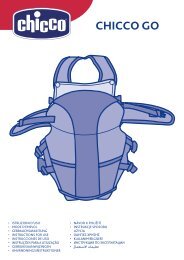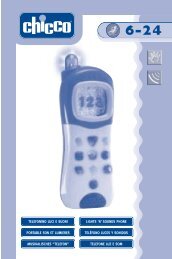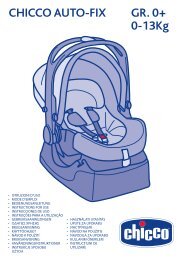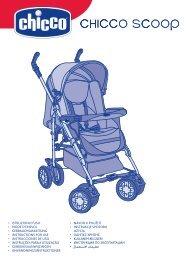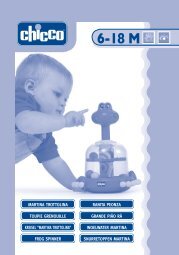Scaldabiberon Pappacalda Digital - Chicco
Scaldabiberon Pappacalda Digital - Chicco
Scaldabiberon Pappacalda Digital - Chicco
Create successful ePaper yourself
Turn your PDF publications into a flip-book with our unique Google optimized e-Paper software.
• Place the feeding bottle warmer only on flat, stable surfaces, out of reach of children. Never place the<br />
equipment near cradles or cots, since, during use, the container and the water contained in it become<br />
very hot. Always use and handle the equipment with the maximum care!<br />
• Never place the feeding bottle warmer on top of, or near hot surfaces, gas rings or electric hot plates,<br />
or on delicate surfaces sensitive to heat and/or humidity.<br />
• Never operate the feeding bottle warmer without water inside the heating chamber.<br />
• Only use feeding bottles made of heat-resistant plastic or thermo-resistant glass: do not use disposable<br />
feeding bottles.<br />
• Do not move the feeding bottle warmer during use or when it still contains hot liquids.<br />
• After use, always allow the feeding bottle warmer to cool down completely.<br />
• When not in use, and before cleaning or storing the feeding bottle warmer, always disconnect the<br />
power cable plug from the mains socket, and let it cool down completely.<br />
• Before feeding baby, always check the temperature of contents (it must not exceed 37°C).<br />
• For hygiene and health reasons, feeding bottle warmers must only be used to warm up pre-cooked baby<br />
food, not to cook it. It is recommended to warm up food at 37°C. Never warm up food more than<br />
once, or for more than one hour.<br />
• The final temperature of the food and the heating time could vary according to the quantity of food<br />
being heated, the initial (room or fridge) temperature, the density of the food, the position of the temperature<br />
adjustment knob, as well as the type and size of feeding bottle used (plastic or glass feeding<br />
bottle, baby food jar).<br />
The use of any electrical equipment requires compliance with some fundamental rules.<br />
In particular:<br />
• The electrical system of the room must always conform to the safety regulations in force.<br />
• Ensure that equipment voltage and frequency (see the rated voltage plate located underneath the<br />
equipment) correspond to the voltage and frequency of the mains.<br />
• Plug the equipment to a mains socket that is easily accessible.<br />
• Do not pull the mains cable or the appliance to unplug the equipment from the mains.<br />
• The feeding bottle warmer must be used in compliance with the instructions supplied.<br />
• Do not leave the feeding bottle warmer exposed to atmospheric agents (rain, sun, etc.).<br />
• Do not submerge or wet the plug, feeding bottle warmer, or power cable in water or other liquids.<br />
• Never touch the feeding bottle warmer with wet or damp hands.<br />
• Do not touch the feeding bottle warmer if it has fallen accidentally in the water. Should this happen,<br />
unplug the equipment immediately and do not use it; contact a qualified technician or one of Artsana<br />
S.p.A.’s authorised retailers.<br />
• If the feeding bottle warmer is damaged and / or not working correctly, switch it off and disconnect the<br />
plug from the mains socket; do not attempt to open the product, contact a qualified technician or one<br />
of Artsana S.p.A.’s authorised retailers.<br />
• Never leave the equipment unattended when in use.<br />
• Do not leave the feeding bottle warmer switched on continuously for over 60 minutes.<br />
• After one hour of continuous operation, the equipment must always be switched off and allowed to<br />
cool down.<br />
• The feeding bottle warmer can be opened only with special tools. To replace the power cable, only use<br />
a cable similar to the cable supplied with the equipment. The cable must be replaced by a qualified<br />
technician or one of Artsana S.p.A.’s authorised retailers.<br />
• Incorrect repairs carried out by unqualified technicians may cause damage or injuries to the user.<br />
• Dispose of any packaging, worn accessories, and/or the equipment at an appropriate differentiated<br />
collection point, as required by the regulations in force in each country.<br />
9





